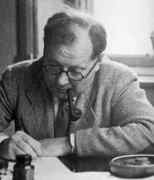Person: Whitehead (2), Henry

J H C Whitehead was a topologist and differential geometer who is best remembered for his work on homotopy equivalence.
Mathematical Profile (Excerpt):
- Although Henry was born in India he lived in England from the age of about eighteen months.
- His parents then returned to India and Henry saw little of them while he was growing up.
- Henry did quite well at primary school, both academically, socially and in sport.
- Despite the lack of a scholarship to Eton, Whitehead was successful in the Entrance Examination and began a happy period at Eton where he specialised in mathematics, yet never showed himself as a mathematical genius.
- Whitehead wanted to go to Balliol College, Oxford, to study mathematics but his mathematics teacher at Eton did not think that he stood a chance of winning a scholarship.
- The mathematics teacher was wrong, however, and in March 1923 Whitehead did win a scholarship to study at Balliol College.
- However, Nicholson's health was poor and Whitehead was tutored frequently by H Newboult at Merton College.
- As Eton had done, however, Oxford also provided a whole range of distractions to Whitehead.
- At Oxford Whitehead developed another passion, namely playing poker.
- Whitehead played poker for quite large sums of money while at Oxford although his friends did not always pay what they owed him.
- At Oxford Whitehead showed himself to be better than the "good" at mathematics which he had displayed at Eton.
- By this time his parents had returned from India and were living in the village of Sulham in Berkshire and Whitehead lived there and travelled to his job in the city of London every day.
- It took not much over a year of work at the stockbrokers to convince Whitehead that the City was not the life for him so, in 1928, he returned to the University of Oxford.
- While at Oxford Whitehead met Veblen, who was on leave from Princeton.
- He attended a seminar which Veblen gave on differential geometry and it must have been a very fine talk for it persuaded Whitehead that he would undertake research in that topic.
- Veblen supported Whitehead's application for a Commonwealth Fellowship to enabled him to study for a Ph.D. at Princeton.
- Whitehead arrived at Princeton in the summer of 1929 to begin his research.
- Whitehead's joint work with his doctoral supervisor Veblen led to The Foundations of Differential Geometry (1932), now considered a classic.
- As we mentioned Whitehead's interests turned more towards topology near the end of his three years in Princeton when he collaborated with Lefschetz in proving that all analytic manifolds can be triangulated.
- Whitehead returned to Oxford after being awarded his doctorate and he was elected to a Fellowship at Balliol College in 1933.
- Soon after his return to England, Whitehead wrote another major work on differential geometry On the Covering of a Complete Space by the Geodesics Through a Point (1935).
- Whitehead also studied Stiefel manifolds and set up a school of topology at Oxford.
- However, events would soon cause a break in Whitehead's career.
- The Nazi moves against Jewish mathematicians gave Whitehead great distress, and he actively helped many to escape to safety.
- At that time Whitehead moved from Balliol College to Magdalen College.
- Whitehead received several honours for outstanding mathematical achievements, but he died at the age of 55 when at the height of his powers, so did not live to receive awards which normally come later in life.
Born 11 November 1904, Madras, (now Chennai) India. Died 8 May 1960, Princeton, New Jersey, USA.
View full biography at MacTutor
Tags relevant for this person:
Origin India, Topology
Thank you to the contributors under CC BY-SA 4.0! 

- Github:
-

- non-Github:
- @J-J-O'Connor
- @E-F-Robertson
References
Adapted from other CC BY-SA 4.0 Sources:
- O’Connor, John J; Robertson, Edmund F: MacTutor History of Mathematics Archive
